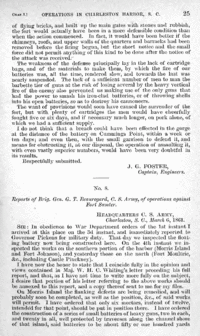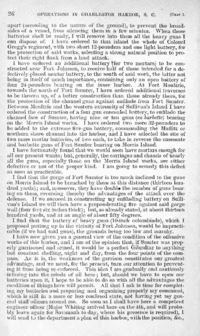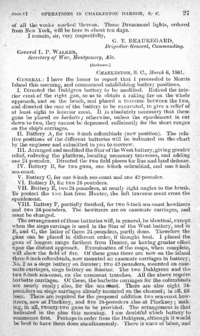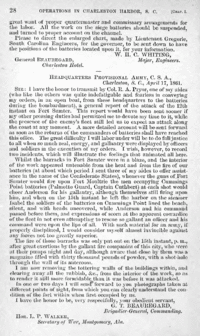 Click for full-sized scanned image  Click for full-sized scanned image  Click for full-sized scanned image Reports of Brigadier General G.T. Beauregard, C.S. Army, of operations against Fort Sumter.
HEADQUARTERS C.S. ARMY,
Charleston, S.C.,
March 6, 1861.
SIR: In obedience to War Department orders of the 1st instant I arrived at this place on the 3rd instant, and immediately reported to Governor Pickens for military duty. That day we inspected the floating battery now being constructed here. On the 4th instant we inspected the works on the southern portion of the harbor (Morris Island and Fort Johnson), and yesterday those on the north (Fort Moultrie, &c., including Castle Pinckney).
I have now the honor to state that I coincide fully in the opinion and views contained in Major W.H.C. Whiting's letter preceding his full report, and that, as I have not time to write more fully on the subject, I desire that portion of his letter referring to the above works should be annexed to this report, and a copy thereof sent to me for my files.
On Morris Island the flanking defects are being remedied, and will probably soon be completed, as well as the position, &c., of said works will permit. I have ordered that only six mortars, instead of twelve, intended for that point, should be put in position there. I have ordered the construction of a series of small batteries of heavy guns, two in each, and twenty in all, well protected by traverses along the channel shore of that island, said batteries to be about fifty or one hundred yards apart (according to the nature of the ground), to prevent the broadsides of a vessel, from silencing them in a few minutes. When those batteries shall be ready, I will remove into them all the heavy guns I can dispose of. I have ordered to that island the whole of Colonel Gregg's regiment, with two short 12-pounders and one light battery, for the protection of said works, selecting a strong natural position to protect their right flank from a land attack.
I have ordered an additional battery (for two mortars) to be constructed near Fort Johnson, to receive half of those intended for a defectively-placed mortar battery, to the south of said work, the latter not being in itself of much importance, containing only and open battery of four 24-pounders bearing on the inner harbor. At Fort Moultrie, towards the north of Fort Sumter, I have ordered additional traverses to be thrown up, of a better construction than those already there, for the protection of the channel guns against enfilade from Fort Sumter. Between Moultrie and the western extremity of Sullivan's Island I have ordered the construction of a four-gun concealed battery, to enfilade the channel face of Sumter, having nine or ten guns (en barbette) bearing on the Morris Island works. I have ordered two more 32-pounders to be added to the extreme five-gun battery, commanding the Maffitt or northern shore channel into the harbor, and I have selected the site of two more mortar batteries, of two each, to take in reverse the casemate and barbette guns of Fort Sumter bearing on Morris Island.
I have fortunately found that we would soon have mortars enough for all our present wants; but, generally, the carriages and chassis of nearly all the guns, especially those on the Morris Island works, are either defective or not of the proper kind. I am going to remedy this defect as soon as practicable.
I find that the gorge of Fort Sumter is too much inclined to the guns on Morris Island to be breached by them at this distance (thirteen hundred years); and, moreover, they have double the number of guns bearing on them, reversing thereby the advantages of the attack over the defense. If we succeed in constructing my enfilading battery on Sullivan's Island we will then have a preponderating fire against said gorge wall (four feet six inches thick); but, as already stated, at about thirteen hundred yards, and at an angle of about fifty degrees.
I find that the battery of heavy guns (10-inch columbiads), which I proposed putting up in the vicinity of Fort Johnson, would be impracticable (if we had said guns), the grounds being too low and marshy.
I have now given you a general view of the condition of the offensive works of this harbor, and I am of the opinion that, if Sumter was properly garrisoned and armed, it would be a perfect Gibraltar to anything bus constant shelling, night and day, from the four points of the compass. As it is, the weakness of the garrison constitutes our greatest advantage, and we must, for the present, turn our attention to preventing it from being re-enforced. This idea I am gradually and cautiously infusing into the minds of all here; but, should we have to open our batteries upon it, I hope to be able to do so with all the advantages the condition of things here will permit. All that I ask is time for completing my batteries and preparing and organizing properly my command, which is still in a more or less confused state, not having yet my general staff officers around me. So soon as I shall have here a competent engineer officer (Major Whiting arrived here on the 4th, and will probably heave again for Savannah to day, where his presence is required), I will send to the department a plan of this harbor, with the position, &c., of all the works marked thereon. Those Drummond lights, ordered from New York, will be here in about ten days.
I remain, sir, very respectfully,
G.T. BEAUREGARD,
Brigadier-General, Commanding.
to General L.P. WALKER,
Secretary of War, Montgomery, Ala.
[Inclosure.]
| March 6, 1861 - Brigadier General G.T. Beauregard to Major William Whiting
|
 Click for full-sized scanned image  Click for full-sized scanned image Reports of Brigadier General G.T. Beauregard, C.S. Army, of operations against Fort Sumter.
CHARLESTON, S.C.,
March 6, 1861.
GENERAL: I have the honor to report that I proceeded to Morris Island this morning, and commenced establishing battery positions.
I. Directed the Dahlgren battery to be modified. Retired the interior crest of the right gun, so as to obtain a raking fire on the whole approach, and on the beach, and placed a traverse between the two, and directed the rear of the battery to be excavated, to give a relief of at least eight to interior crest. It is absolutely necessary that these guns be placed en barbette; otherwise, unless the epaulement is cut down to two, they cannot be depressed sufficiently for the short ranges on the ship's carriages.
II. Battery A, for two 8-inch columbiads (new position). The relative positions of the different batteries will be indicated on the chart by the engineer and submitted to you to-morrow.
III. Arranged and modified the Star of the West battery, giving greater relief, reducing the platform, locating necessary traverses, and adding one 24-pounder. Directed the two field pieces for line and land defense.
IV. Battery B, for two guns, one 8-inch columbiad, and one 8-inch sea-coast.
V. Battery C, for one 8-inch sea-coast and one 42-pounder.
VI. Battery D, for two 24-pounders.
VII. Battery E, two 24-pounders, at nearly right angles to the brush. To protect the two last from Hunter, the left traverse must cross the epaulement.
VIII. Battery F, partially finished, for two 8-inch sea-coast howitzers and two 24-pounders. The howitzers are on casemate carriages, and must be changed.
The arrangement of these batteries will, in general, be identical, except when the siege carriage is used in the Star of the West battery, and in E, and G, the latter of three 24-pounders, partly done. Therefore the guns can be placed in different order, if thought best. I placed the guns of longest range farthest from Hunter,, as having greater effect upon the distant approach. Examination of the maps, when complete, will show the field of fire. Of these guns there are now on the island three 8-inch columbiads, now mounted on casemate carriages in battery; Numbers 2 as a siege battery on Sumter; two 42-pounders, mounted on casemate carriages, siege battery on Sumter. The two Dahlgrens and the two 8-inch sea-coast, on the casement trenches. All the above require barbette carriages. Of these, the barbette carriages for the columbiads are nearly ready; also, for the sea coast. There are also eight 24-pounders on siege carriages already mounted on the channel; in all, fifteen. There are required for the proposed addition two sea-coast howitzers, now at Pinckney, and five 24-pounders also at Pinckney; making, in all, twenty-two guns to be provided. The arrangement is that indicated in the plan this morning. I am doubtful which battery to commence first. Perhaps in order from the Dahlgren, although it would be best to have them done simultaneously. There is want of labor, and great want of proper quartermaster and commissary arrangements for the labor. All the work on the siege batteries should be suspended, and turned to proper account on the channel.
Please to direct the enlarged chart, made by Lieutenant Gregorie, South Carolina Engineers, for the governor, to be sent down to have the positions of the batteries located upon it, for your information.
W.H.C. WHITING,
Major, Engineers.
to General BEAUREGARD,
Charleston Hotel.
(To view this page in its Source Category, click HERE for Part 1 and HERE for Part 2)
|
(To view this page in its Source Category, click
|